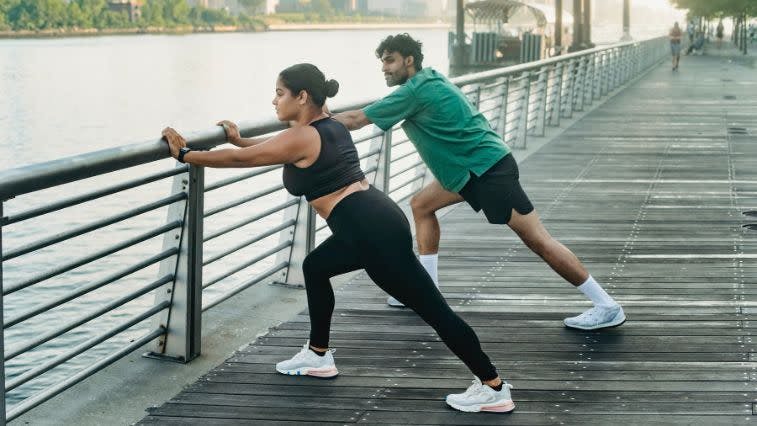How Should You Really Be Doing a Warm Up and Cool Down? Find Out From a Personal Trainer and Physical Therapist
Our content strives to support, inform, and motivate you to meet your health goals. We want to be your trusted source of expert- and science-backed info dispensed in simple, actionable ways. Read our Editorial Guidelines.
The more exciting strength training, sport, or cardio event often overshadows the importance of warm-up and cool-down techniques. However, without preparing your body to work, you could not only put yourself at risk of injury but also miss out on potential performance and progress benefits.
What’s more, cooldowns are not just a good idea for helping you safely bring your heart rate back down—they serve a crucial purpose you may not be aware of. Even though fitness has been a lifelong passion for me, and I consider myself well-versed and educated in all things workout related, I admit to skipping cooldowns before I learned their true power.
Below, I’ll break down the importance and benefits of proper warm-up and cool-down techniques, along with help from New York Times and Wall Street Journal best-selling author Dr. Kelly Starrett, a physical therapist and co-author of the new book Built To Move.
The Basics and Purpose of a Good Warm-Up
Warm-ups are a precursor to your exercise session that typically include some light cardio and movements or light sets that mimic how your body will move during your training session. In the simplest terms, a warmup is meant to prepare our bodies to have better training, sport, or play experience, according to Starrett.
If you are over 25 to 30, your body may not be able to rock your training right out of the gait. You might feel tight, lethargic, unmotivated, or weak. “If we pan back, there are very few sports where we’ll see an athlete get out of the van and move very quickly. Through that lens, we intuitively know that humans competing feel better when they’ve hit some of the ideas and principles behind a good warmup,” says Starrett.
The basics accomplishments of a good warm-up, according to Starrett, include:
Shifting blood to the heart. Blood will be redirected from your stomach and other veins to your heart. t takes a second to shift that blood back into the system.
Regulating arousal in the brain. Become more turned on by activating and notifying your central nervous system (CNS) that it’s time to work.
Raising body temperature. We want to ensure that the blood has a second to perfuse our tissues and get our ligaments, tendons, and joints full of blood.
Preparing you for positions. Movement preparation reminds us about the skills we’re about to engage in. It allows us to touch base with key shapes (body positions) we will need for our sport. It tells the brain that it’s safe to go to these positions.
Centering and getting you ready. Warm-ups help us prepare to partner with others to play a sport or engage with our training partner. Use play as a warmup or a time to experience other movements and expose ourselves to positions and shapes.
Don’t be afraid to play and experiment with your warm-ups. This can help build motivation and excitement for training. “We can expand this idea of “Hey, I’m just sitting on the bike, going through the motions” to a real opportunity to put in some fun movements and prep ourselves for what is going on,” says Starrett. Good warmups allow us to assess what’s happening and prepare our bodies for a metaphorical fight. We should be able to see increased performance out of that.
The Basics and Purpose of a Good Cool Down

Cooling down is one of the most neglected aspects of training that I see. Even good trainers sometimes skimp on cooling down their clients, but this last bit of your training is vital. “Theoretically, if I’ve just come out a brutal piece [of activity], is flopping on the ground and then jumping into a car the best way to manage that adaptation response? Probably not,” explains Starrett.
Ultimately, we’d love not to have people go from red line to sitting—that’s how we put horses in the hospital. “Even horses do cool-down laps after the Kentucky Derby. For horses, you can’t be run hard and put away wet,” says Starrett. The same is true with humans.
The basics accomplishments of a good cool-down include:
Returning to a relaxed state. Just as you activated and aroused your CNS in your warm-up, you should relax and return it to a parasympathetic (rest and digest) state afterward.
Preventing stiffness. Continuing to be in movement teaches our bodies to buffer that lactate that keeps us from becoming stiff.
Helping with transition: You have a chance to adapt and think about what’s going on, getting in touch with your body and what you just accomplished while preparing for the rest of your day.
Proper Warm-Up Techniques
How you should warm up will vary depending on what type of activity you will do. Starrett recommends thinking about warm-ups as skill development. Use your warm-up time to practice and prepare for the skills you will use during your training.
Cardio and Sport-Based Warm-Up Techniques

If you are performing a more extended cardio-based session, you can begin with a walk and start moving a little faster. If it’s sports, your warmup should be touching some of the skills you will use by practicing the motions more intentionally.
You should also ensure that you can access some of the ranges of motion you will use during your workout, along with touching the heart rate intensities you will be going up to as part of the warm-up. “You don’t have to spend the first part of your game or competition warming up,” advises Starrett.
If you tend to get tight or sore from your cardio sessions, the time to work on your mobility and flexibility is during your recovery days. You do not need to spend a lot of time stretching before your cardio session. In fact, stretching can sometimes be detrimental before your workout since it can lead to less stability which may cause injury.
If you want to feel more mobile and loose before running, biking, swimming, or hitting a machine, some light basic dynamic mobility movements can help. Try exercises like gate openers, runner’s lunge, shin box, inchworms, and bird dogs.
Weight Lifting Warm-Up Techniques
When it comes to weightlifting, perform cardio and dynamic movements that mimic what you will be doing during your training session. Some of these movements should also be powerful, helping you activate your CNS. For instance, try bodyweight squats and jump squats before a squatting day or pushups and ball slams before bench pressing.
Next, you should perform warm-up sets, which are lighter versions of your working weight sets. For instance, if you plan to squat 150lb, try warming up first with body weight for 20 reps, then the bar for 10 reps, then with 100lb for 8 reps, then go into your working set.
Starrett says top weightlifters will often add more movement between each warm-up set. Try moving, stretching, and getting tissues hot and sweaty—just reminding the brain about what is required.
“The only other thing I would say is if we are engaged in specific activities that require full capacity, full range of motion, like weightlifting, then that may be a time to drop in a quick mobilization to help me achieve a position that will be required for the sport,” he says. For instance, that can mean working on hip and ankle mobility to prepare for squatting.
Proper Cool Down Techniques
Cooling down from a workout is much more straightforward. You can do the same type of cool-down after any training. The idea is to return to a resting state, lowering stress hormones and calming the body. Cooldowns promote recovery and repair and improve digestion, stress, and wellbeing.
Methods for cooling down include gentle stretching, restorative yoga poses like corpse pose, happy baby pose, or child’s pose, lying with your legs elevated on a bench or up a wall, and box breathing. Warm showers, baths, myofascial release with a foam roller or massage gun, or sauna visits are also helpful.
Age Matters
I’d be remiss if I didn’t address that spring chickens will have a much easier time picking up and getting to their workouts than older folks. The older you get, the more you must incorporate thorough, intentional warmups.
According to Starrett, age factors in massively when considering your warmup. “Kindergarteners bolt from the door, and if I took a fifty-year-old and had them sit in an office all day long and then bolt for the door for recess, they would pull a hammy,” he says.
As we age, we probably need a little more time to warm up, bring tissue temperatures on board, and ensure tissues are well-perfused just because we don’t have some of the same tolerances as we used to.
“In short, when we have younger people, we try to get right into the activity as fast as possible with skills and games. We don’t stand around to talk; we start jump-roping and playing. But for older athletes, we really do want them to start to get hot and sweaty so they can feel better, and we get slower and take more work-up sets,” explains Starrett.
According to Starrett, just because of the patina of age, we have tissues with experience and maybe a history of trauma. We need to get things prepped. “One of our elite athletes says, “I can do anything once I’m warmed up.” He happens to be fifty,” he concludes.
Learn the proper techniques for warm-ups, cooldowns, and other foundational fitness topics from an expert. Sign up for a free consultation with a certified personal trainer today.